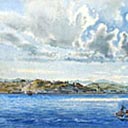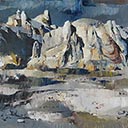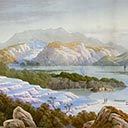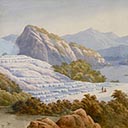Town of Oamaru from the Sea - circa 1878
20 x 59 cm
est. $5,000 - 10,000
In 1877 Gifford settled in Oamaru where he would spend the greater part of the next eighteen years. The many studies and townscapes executed during this time document the defining age of Oamaru when new industries flourished and much of the towns limestone architecture was created. Oamaru's early prosperity stemmed from its status as a port. The busy harbour became a favourite subject for Gifford.
In his final years Gifford produced very few works. He died suddenly in 1894 at his Lune Street residence. He is widely remembered as a quiet, gentle painter of exceptional merit. (Forrester Gallery Oamaru)
It is no exaggeration to say that Mr Gifford was, perhaps, the greatest artist in the colonies, and the work he leaves behind him sufficient to bear testimony to his talent (Oamaru Mail, 9th November 1894)
Ports were the beachheads of colonial expansion. No town could prosper without one. Those that had natural harbours spent huge sums deepening them to accommodate ever larger ships. Towns that lacked natural harbours spent even more money - Harbours where nature has not provided them, as Otago's provincial harbourmaster complained in 1868 - and risked bankruptcy doing so. Napier, New Plymouth, Timaru and Oamaru all built big artificial harbours to stay in the progress game. Oamaru Harbour closed to shipping in 1974 and is now a registered historic place. It's the best place in the country to see how and why all New Zealanders once depended so heavily on sea transport. Landmarks Kenneth Cumberland, Readers Digest 1982





